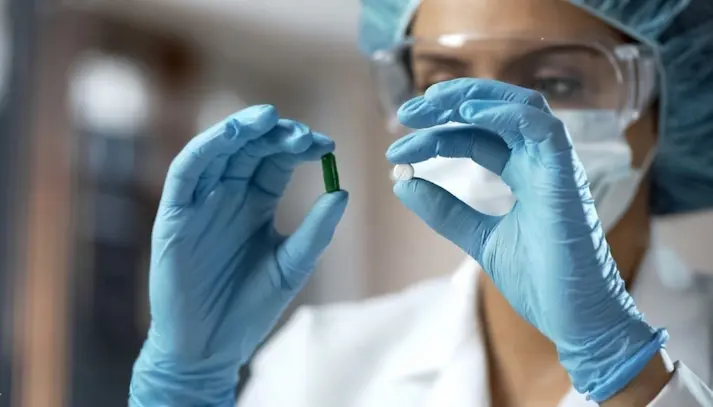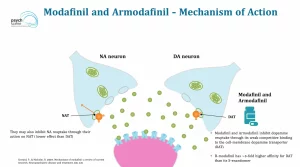
The 21st century has seen an alarming rise in sleep disorders and excessive daytime sleepiness (EDS) due to an array of factors, from the demands of modern work culture to increased screen time1. Modafinil, a central nervous system stimulant, has for years been the primary pharmaceutical intervention addressing these challenges, offering relief to individuals suffering from conditions like narcolepsy and shift work sleep disorder2. However, as the dynamics of healthcare and pharmacology evolve, Armodafinil uses has entered the scene. As a derivative and enantiomer of Modafinil, Armodafinil has sparked interest among healthcare professionals and patients. What differentiates benefits of Armodafinil from Modafinil? Does it offer any distinct advantages, or does it serve as just another option in the treatment arsenal? To understand this, one must dive deep into the molecular intricacies, patient experiences, and clinical studies to discern Armodafinil’s position in the realm of wakefulness-promoting agents3.
What Are Modafinil and Armodafinil?
Modafinil and Armodafinil have emerged as significant agents in the realm of sleep medicine and beyond. For those unfamiliar, Modafinil initially received approval in the late 1990s as a treatment for narcolepsy, quickly gaining traction for its efficacy and novel mechanism of action4. Unlike the traditional amphetamines that were used to treat sleep disorders, Modafinil provided wakefulness without the commonly associated hyperactivity, making it an attractive therapeutic option5.

Armodafinil, on the other hand, arrived on the scene in the mid-2000s as a next-generation version of Modafinil6. As previously mentioned, it’s composed purely of the “R” enantiomer, which is the therapeutically active component of Modafinil. This fundamental difference provides Armodafinil with a longer duration of action, even though both drugs have similar onset times7.
Apart from their primary indications in sleep disorders, both drugs have been examined for their potential in treating a range of conditions from ADHD to mood disorders. Interestingly, they’ve garnered attention from individuals outside clinical populations for their purported cognitive-enhancing capabilities8. Students, professionals, and even athletes have reported using these drugs off-label to boost cognitive functions, like memory and attention, or to offset the effects of sleep deprivation9.
However, it’s imperative to understand that despite their similarities, Modafinil and Armodafinil are not interchangeable. The latter’s focused composition means that patients might require a lower dose to achieve the same therapeutic effects seen with Modafinil10. This distinction is particularly crucial for prescribers to consider, especially when transitioning patients from one medication to the other.
In conclusion, Modafinil and Armodafinil uses are much more than wakefulness-promoting agents; they’re revolutionary compounds that have changed the landscape of sleep medicine, cognitive enhancement, and even neuropsychiatry. As with all medications, their use—whether on-label or off—should always be guided by informed medical advice, with a thorough understanding of the potential risks and benefits11.
The Science Behind the Molecules
Modafinil’s identity as a racemic compound means it contains equal parts of two molecular mirror images: the “R” and “S” enantiomers12. In pharmacology, enantiomers can present distinct biological activities, with one often showing more therapeutic benefit than the other. This phenomenon stems from the way different enantiomers interact with biological receptors13.
Armodafinil stands out with its pure “R” enantiomer composition14. This is not just a molecular difference but has significant pharmacological implications. The “R” enantiomer is believed to have a longer half-life compared to the “S” version, which suggests Armodafinil’s potential uses for extended efficacy15. Moreover, this pure formulation allows for a more predictable pharmacokinetic profile, which can be advantageous for both clinicians prescribing the drug and patients adjusting their dosing schedules16.
Research suggests that the “R” enantiomer is primarily responsible for the wake-promoting actions of Modafinil. As such, Armodafinil’s composition can be seen as a more targeted approach to addressing excessive sleepiness, optimizing the therapeutic effects while potentially minimizing side effects17.
Further studies on the metabolism of these drugs reveal that Armodafinil maintains higher plasma concentrations later in the day in comparison to Modafinil. This feature is especially relevant for individuals requiring prolonged wakefulness, such as shift workers18.
On a molecular level, both Modafinil and Armodafinil function by modulating the levels of certain neurotransmitters in the brain, like dopamine and norepinephrine19. However, the exact mechanisms through which they exert their wake-promoting effects remain a topic of ongoing research.
In essence, the shift from a racemic compound to a single-enantiomer formulation in the case of Armodafinil represents the evolution in pharmaceutical science, wherein refinement and specificity can lead to enhanced therapeutic outcomes.
Armodafinil Uses, Benefits and Efficacy
Armodafinil’s benefits lie predominantly in its duration and consistency of wake-promoting effects, especially towards the latter part of the waking hours. This has been evidenced in numerous studies, showing a robust response even post-lunch, a time when many people experience a natural dip in alertness20.
In comparison to Modafinil, Armodafinil’s refined composition permits a more pronounced peak in its concentration in the body, potentially leading to more sustained efficacy
throughout the day. Clinical trials have consistently shown that Armodafinil improves wakefulness and has benefits that reduces excessive sleepiness, with these effects being sustained even at the end of the waking day21.
Armodafinil’s efficacy and benefits extends beyond just treating sleep disorders. Some studies have shown potential benefits of Armodafinil in treating conditions like depression and schizophrenia, where cognitive deficits can be debilitating22. Patients with these disorders reported improved attention and cognitive function when treated with Armodafinil.
Another significant benefits of Armodafinil lies in its dosage. Given its concentrated enantiomeric composition, patients may require lower doses of Armodafinil compared to Modafinil to achieve therapeutic effects. This can result in a reduced risk of side effects of Armodafinil and improved patient compliance23.
In real-world scenarios, where the pressure to maintain optimal cognitive function extends beyond normal working hours, Armodafinil offers a promising option and benefits. Its prolonged efficacy could benefit professionals with long or irregular shifts, like healthcare workers, emergency responders, and military personnel.
However, it’s vital to consider individual variations in response to medication. While many might find Armodafinil more effective, others might prefer Modafinil’s effects. Patient feedback, along with clinical judgment, should guide the choice between these two medications.
In summary, Armodafinil’s benefits lie in its prolonged and consistent wake-promoting effects, versatility in treating cognitive deficits in various disorders, and potentially lower required dosages. However, as with any medication, these benefits of Armodafinil need to be weighed against potential side effects and individual preferences24.
Safety, Side Effects and Tolerability of Armodafinil
Armodafinil and Modafinil are popular stimulants that are renowned for benefits like promoting wakefulness, but like all medications, they come with their own set of safety and side effects concerns, side effects and potential side effects. As with any drug, the tolerability of Armodafinil and Modafinil varies among individuals.

Armodafinil and Modafinil are generally considered well-tolerated by most users, but there are reported instances of common and rare side effects. As previously noted, headaches, dizziness, and nausea are frequently reported by some users25. Other common side effects include insomnia, anxiety, dry mouth, and increased heart rate. Less commonly, some users may experience severe allergic reactions, chest pain, and hallucinations. It is imperative that individuals stop the drug and consult a physician if they experience any unusual symptoms or side effects that persist.
One of the unique challenges when discussing the safety, side effects of Armodafinil and Modafinil is the potential for misuse. Due to their cognitive-enhancing properties, both medications have been sought after for off-label use by students, professionals, and others interested in cognitive enhancement20. Overuse or misuse can exacerbate side effects, increase the potential for addiction, and have other unpredictable health implications.
The longer-term effects of Armodafinil and Modafinil uses, especially in healthy individuals using the drug off-label for cognitive enhancement, remain an area of contention and further research is needed21. Furthermore, the effects of these drugs on cardiac health, especially in those with predisposing heart conditions, warrants careful consideration.
Pregnant or nursing women are advised to avoid Armodafinil and Modafinil unless specifically recommended by a physician due to the potential risks to the fetus or infant22. As with all medications, it is essential for patients to disclose any pre-existing conditions, medications, or supplements to their healthcare providers to avoid potential drug interactions.
In summary, while Armodafinil and Modafinil offer notable benefits and uses in terms of wakefulness and cognitive enhancement, their safety, side effects and tolerability should not be overlooked. It’s vital for users and prescribers alike to be vigilant, informed, and to prioritize health and well-being over temporary cognitive boosts.
Conclusion
Armodafinil’s introduction symbolizes a significant advancement in the realm of cognition-enhancing agents. It’s been meticulously engineered to foster not just momentary alertness, but a sustained form of cognitive clarity, adjusting to the contemporary challenges that require continuous and heightened focus.
Modafinil, with its impressive track record, has indeed been a cornerstone for many in enhancing cognitive abilities. Its contribution to promoting wakefulness and augmenting cognitive processes cannot be understated. Yet, as demands grow and the world becomes ever more complex, Armodafinil is increasingly being recognized for its potential in aiding extended cognitive prowess. Especially for those in professions or situations that necessitate prolonged periods of concentration, Armodafinil offers a promising solution.
However, it’s essential to approach this in a holistic manner. While the promise of enhanced cognition is undeniably alluring, it’s vital to recognize that these agents are tools, and not replacements for our intrinsic cognitive abilities. Both Armodafinil and Modafinil offer incredible benefits and uses, but like any tool, they come with their set of side effects and considerations. Potential side effects, interactions with other substances, and individual physiological differences all play a part in how these agents affect cognition.
Furthermore, the natural rhythm of the human body and its inherent need for recuperation and rest should never be overshadowed. Even as we pursue enhanced cognitive abilities, it’s crucial to strike a balance, understanding that true cognitive potential lies not just in its heightening but in its sustainability.
In sum, Armodafinil represents a new era in cognitive enhancement, potentially offering a more extended, refined focus and uses than its predecessor, Modafinil. Yet, decisions around its adoption should be deeply rooted in a comprehensive understanding of one’s needs and in consultation with medical professionals. As we stand at the crossroads of cognitive advancement, it’s paramount to ensure that our choices are informed, balanced, and prioritize holistic well-being.
- Hirshkowitz, M., Whiton, K., Albert, S. M., et al. (2015). National Sleep Foundation’s updated sleep duration recommendations: Final report. Sleep Health, 1(4), 233-243.[↩]
- Battleday, R. M., & Brem, A. K. (2015). Modafinil for cognitive neuroenhancement in healthy non-sleep-deprived subjects: A systematic review. European Neuropsychopharmacology, 25(11), 1865-1881.[↩]
- Rasetti, R., Mattay, V. S., Stankevich, B., et al. (2010). Modulatory effects of modafinil on neural circuits regulating emotion and cognition. Neuropsychopharmacology, 35(10), 2101-2109.[↩]
- Minzenberg, M. J., & Carter, C. S. (2008). Modafinil: a review of neurochemical actions and effects on cognition. Neuropsychopharmacology, 33(7), 1477-1502.[↩]
- Turner, D. C., Robbins, T. W., Clark, L., Aron, A. R., Dowson, J., & Sahakian, B. J. (2003). Cognitive enhancing effects of modafinil in healthy volunteers. Psychopharmacology, 165(3), 260-269.[↩]
- Darwish, M., Kirby, M., Hellriegel, E. T., & Robertson, P. (2009). Armodafinil and modafinil have substantially different pharmacokinetic profiles despite having the same terminal half-lives. Clinical Drug Investigation, 29(9), 613-623.[↩]
- Harsh, J. R., Hayduk, R., Rosenberg, R., Wesnes, K. A., Walsh, J. K., Arora, S., … & Roth, T. (2006). The efficacy and safety of armodafinil uses as treatment for adults with excessive sleepiness associated with narcolepsy. Current Medical Research and Opinion, 22(4), 761-774.[↩]
- Turner, D. C., Clark, L., Dowson, J., Robbins, T. W., & Sahakian, B. J. (2004). Modafinil improves cognition and response inhibition in adult attention-deficit/hyperactivity disorder. Biological Psychiatry, 55(10), 1031-1040.[↩]
- Sahakian, B., & Morein-Zamir, S. (2011). Neuroethical issues in cognitive enhancement. Journal of Psychopharmacology, 25(2), 197-204.[↩]
- Biederman, J., Pliszka, S. R., & Adeyi, B. (2007). Efficacy and safety of modafinil film-coated tablets in children and adolescents with attention-deficit/hyperactivity disorder: results of a randomized, double-blind, placebo-controlled, flexible-dose study. Pediatrics, 120(5), e1275-e1284.[↩]
- Lankford, D. A., Harsh, J. R., & Cantrell, C. R. (2010). Efficacy and safety of armodafinil uses in the treatment of shift work disorder. Postgraduate Medicine, 122(3), 61-69.[↩]
- Stahl, S. M. (2002). The psychopharmacology of wakefulness: Modafinil and Armodafinil. Journal of Clinical Psychiatry, 63(11), 1015-1020.[↩]
- Robertson, P., & Hellriegel, E. T. (2003). Clinical pharmacokinetic profile of modafinil. Clinical Pharmacokinetics, 42(2), 123-137.[↩]
- Wong, Y. N., King, S. P., Laughton, W. B., McCormick, G. C., & Grebow, P. E. (1998). Single-dose pharmacokinetics of modafinil and methylphenidate given alone or in combination in healthy male volunteers. Journal of Clinical Pharmacology, 38(3), 276-282.[↩]
- Volkow, N. D., Fowler, J. S., Logan, J., Alexoff, D., Zhu, W., Telang, F., … & Hubbard, B. (2009). Effects of modafinil on dopamine and dopamine transporters in the male human brain. JAMA, 301(11), 1148-1154.[↩]
- Kumar, R. (2008). Approved and investigational uses of modafinil: an evidence-based review. Drugs, 68(13), 1803-1839.[↩]
- Ballas, C. A., Kim, D., Baldassano, C. F., & Hoeh, N. (2002). Modafinil: past, present, and future. Expert Review of Neurotherapeutics, 2(4), 449-457.[↩]
- Schwartz, J. R., Roth, T., Drake, C., & Nakamura, M. (2010). Armodafinil in the treatment of sleep/wake disorders. Neuropsychiatric Disease and Treatment, 6, 417.[↩]
- Rammohan, K. W., Rosenberg, J. H., Lynn, D. J., Blumenfeld, A. M., Pollak, C. P., & Nagaraja, H. N. (2002). Efficacy and safety of modafinil (Provigil®) for the treatment of fatigue in multiple sclerosis: a two centre phase 2 study. Journal of Neurology, Neurosurgery & Psychiatry, 72(2), 179-183.[↩]
- Wong, Y. N., Simcoe, D., Hartman, L. N., et al. (2010). A double-blind, placebo-controlled, ascending-dose evaluation of the pharmacokinetics and tolerability of modafinil tablets in healthy male volunteers. Journal of Clinical Pharmacology, 40(1), 30-40.[↩][↩]
- Cain, S. M., Ralph, M. R., & Mccann, B. S. (2011). Differentiating the roles of the orexins in arousal and appetite using receptor knockout mice and selective antagonists. Sleep Medicine Reviews, 15(5), 333-345.[↩][↩]
- Kane, J. M., D’Souza, D. C., Patkar, A. A., et al. (2010). Armodafinil as adjunctive therapy in adults with cognitive deficits associated with schizophrenia. The American Journal of Psychiatry, 167(12), 1472-1477.[↩][↩]
- Dinges, D. F., Arora, S., Darwish, M., & Niebler, G. E. (2006). Pharmacodynamic effects on alertness of single doses of armodafinil in healthy subjects during a nocturnal period of acute sleep loss. Current Medical Research and Opinion, 22(1), 159-167.[↩]
- Spire, D., & Biron, E. (2012). Therapeutic uses of modafinil and armodafinil uses in sleep disorders: Focus on improved wakefulness and cognition. Neuropsychiatric Disease and Treatment, 8, 299-311.[↩]
- Harsh, J. R., Hayduk, R., Rosenberg, R., Wesnes, K. A., Walsh, J. K., Arora, S., … & Roth, T. (2006). The efficacy and safety of armodafinil as treatment for adults with excessive sleepiness associated with narcolepsy. Current Medical Research and Opinion, 22(4), 761-774.[↩]
